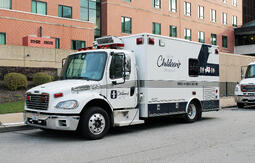Many health systems that delayed construction/renovation projects for the duration of the pandemic are encountering a new problem when re-embarking on these journeys. Construction costs have risen significantly – even doubled from pre-pandemic levels in some cases[i] – as a result of supply chain issues with building materials and labor shortages. Rather than succumbing to the ‘choosing the least of all evils’ mindset and continuing a pre-pandemic journey post-pandemic, health systems may find a better solution by honoring the ways in which the pandemic changed the environment of care. Health systems may consider revisiting whether the decision to build is the best use of capital at this moment in time, or if there are other options that are better investments given the immense shifts that have occurred to some basic assumptions of healthcare.

Tracing back to the 1970s and the managed care era, a tightly held principle of healthcare was, “build it, and they will come.” This tenet had longevity, and to this day it underlies some basic assumptions and decisions made by healthcare leaders – especially for big name healthcare systems. However, this is an antiquated way of thinking that may mire health systems with high overhead costs and empty buildings if they are hyper-focused on expanding care options and attracting patients by building new spaces.
In the late 2000s, as patient-centered care came to prominence, the thinking shifted slightly to, “build it where they already go.” As a result, primary care and specialty care offices were put into retail-heavy areas, and urgent cares and freestanding emergency departments were built closer to high residential populations. When conducting market analyses, one frequently-used indicator to determine attractive locations to situate these outpatient offerings is to place all Starbucks shops on a map and choose sites in close proximity to them. (Admittedly, this is an oversimplification, since the justification for this is not simply that it’s near the retail location but because of the signaling that Starbucks locations have for the demographic attractiveness of the neighborhood known as the Starbucks Effect).
While this change was revolutionary, we believe it is transient. Much like Moore’s Law, in which the pace of innovation in computing chips was exponential, the pace of change in healthcare is going to continue to increase as technological and scientific advancements allow greater options and flexibility (though healthcare’s pace of change will never reach an ‘exponential’ level, there is a lot of room to increase given its historic sluggishness). We believe that in short order, partially because of COVID and partially because of innovations in technology and models of care, the prominent mindset will become, “Bring healthcare to where the patient is: anytime, anyplace, in any number of ways.” There are several examples of care models that are being implemented today that align with this underlying principle.
Telemedicine
 The obvious example of this is telemedicine. With COVID as the catalyst for adoption of this care modality, patients have now experienced on-demand healthcare in their home. While telehealth usage has significantly dropped to only 4.5% of all claims since the apex of the pandemic where it accounted for 13% of all claims, this is still much higher than the pre-pandemic baseline of less than 1%.[ii] Telehealth will not always be the preferred method of care for patients, but as long as congressional rulings do not reinstate the hurdles that existed pre-pandemic, it will likely still be an offering that health systems need to invest in because patients will demand it, especially in specialties that saw the greatest adoption during the pandemic like psychiatry/behavioral health, endocrinology, rheumatology, gastroenterology, and neurology.[iii]
The obvious example of this is telemedicine. With COVID as the catalyst for adoption of this care modality, patients have now experienced on-demand healthcare in their home. While telehealth usage has significantly dropped to only 4.5% of all claims since the apex of the pandemic where it accounted for 13% of all claims, this is still much higher than the pre-pandemic baseline of less than 1%.[ii] Telehealth will not always be the preferred method of care for patients, but as long as congressional rulings do not reinstate the hurdles that existed pre-pandemic, it will likely still be an offering that health systems need to invest in because patients will demand it, especially in specialties that saw the greatest adoption during the pandemic like psychiatry/behavioral health, endocrinology, rheumatology, gastroenterology, and neurology.[iii]
Home Healthcare and Hospital-at-Home Programs
 Another COVID-catalyzed example is home healthcare and hospital-at-home programs. In November of 2020, CMS granted a waiver to six health systems that allowed for Medicare fee-for-service reimbursement of home-based hospital services. By October of 2021, 77 health systems and 177 hospitals had applied for and received theses waivers, allowing them to deliver acute care to select patients in their own homes.[iv] This is not a new model of care when considered globally – there is evidence from many countries with single-payer health systems that high quality hospital-at-home programs can be safer, cheaper, and more effective than traditional care, especially for certain conditions like deep venous thrombosis (DVT) and acute cellulitis.[v] While in the US, the waivers have only been granted temporarily – to last the duration of the public health emergency- several of the top health care organizations have formed the “Advanced Care at Home Coalition” with the mission of pushing legislation that will allow this level of care to be performed in the home going forward.[vi]
Another COVID-catalyzed example is home healthcare and hospital-at-home programs. In November of 2020, CMS granted a waiver to six health systems that allowed for Medicare fee-for-service reimbursement of home-based hospital services. By October of 2021, 77 health systems and 177 hospitals had applied for and received theses waivers, allowing them to deliver acute care to select patients in their own homes.[iv] This is not a new model of care when considered globally – there is evidence from many countries with single-payer health systems that high quality hospital-at-home programs can be safer, cheaper, and more effective than traditional care, especially for certain conditions like deep venous thrombosis (DVT) and acute cellulitis.[v] While in the US, the waivers have only been granted temporarily – to last the duration of the public health emergency- several of the top health care organizations have formed the “Advanced Care at Home Coalition” with the mission of pushing legislation that will allow this level of care to be performed in the home going forward.[vi]
\n addition to health systems lobbying legislation to allow inpatient care at home, the latest version of the Build Back Better Bill would allot $150 billion to reducing waiting lists for in-home care services (though this does not benefit who you may think, as discussed in our article “How President Biden’s $400B Home Care Plan Will Impact Health Systems”) and improving pay for low-wage, in-home care professionals. The bill also contained stipulations for $150 billion to increase the supply of affordable housing and $20 million for hospice and palliative nursing programs.[vii] This support would build up the workforce that would allow more non-acute care to be delivered at home, and while the bill still has several hurdles to overcome, these programs have remained in each version of it.
Not only does it seem that home healthcare’s rise is imminent from a legislative front but also from a technological front. The levels of investment in innovations that allow for healthcare at home – from programming to remote patient monitoring, to wearables – is unprecedented. Choosing to invest in staff and developing the programmatic components of homecare (or to figure out who to outsource with) is another way for health systems to use their limited resources optimally to position themselves for future success.
Mobile Healthcare Offerings
 As a third example of how healthcare is brought to the patient, we can look to mobile healthcare offerings – not in the sense of mobile phones but in terms of mobile vans/busses. Today, this ranges from full mobile health clinics (of which there are about 2,000 across the country accounting for 6.5 million visits per year[viii]) to trucks that have specific equipment, such as mobile MRI, CT, or even full cardiac or vascular labs.[ixi] The former of these has been touted as a way to serve communities with the poorest access to care, helping with preventative health (like PCP visits and cancer screenings like mobile mammography), chronic disease management, and urgent care.[x] While these clinics increase access and equity, they also generate savings – Harvard’s Mobile Health Map project estimates that for every $1 spent on mobile health services, $12 are saved (due to prevention and avoidance of ED visits).[xi] In this instance, these clinics are not putting down roots and making the patient come to them, but maximizing their patient base and impact by traveling to where they are needed.
As a third example of how healthcare is brought to the patient, we can look to mobile healthcare offerings – not in the sense of mobile phones but in terms of mobile vans/busses. Today, this ranges from full mobile health clinics (of which there are about 2,000 across the country accounting for 6.5 million visits per year[viii]) to trucks that have specific equipment, such as mobile MRI, CT, or even full cardiac or vascular labs.[ixi] The former of these has been touted as a way to serve communities with the poorest access to care, helping with preventative health (like PCP visits and cancer screenings like mobile mammography), chronic disease management, and urgent care.[x] While these clinics increase access and equity, they also generate savings – Harvard’s Mobile Health Map project estimates that for every $1 spent on mobile health services, $12 are saved (due to prevention and avoidance of ED visits).[xi] In this instance, these clinics are not putting down roots and making the patient come to them, but maximizing their patient base and impact by traveling to where they are needed.
When considering the more technical imaging and lab vans, common use cases of these services are when hospitals need to catch up on a backlog of patients, need to upgrade or renovate their equipment but would like to continue services, or when there are smaller facilities that can share routes (i.e. three days at one location, three at another).[xii] These are especially attractive options for smaller hospitals that would otherwise not have the capital to build these service offerings on their own (or would not be able to justify the costs based on the expected volume). While mobile solutions have traditionally been thought of strictly in terms of outreach and increasing access, they allow the same flexibility and nimbleness that bely the principle of bringing healthcare to where the patient is: anytime, anyplace, in any number of ways since many of these units are dispatched to community centers like schools, libraries, and local businesses. In today’s construction environment, these may even be short-term solutions for medium to large health systems to avoid excess capital outlays (due to the premiums on materials and labor) while continuing to offer needed services.
In Context of Capital Investment Decisions
While health systems recover from the pandemic, this theme of bringing healthcare to the patient should be investigated and considered when weighing where to direct capital investment dollars. Rather than having a strict focus on building renovations/construction, leaders should consider the ways they can invest in nimble capital assets like technology, staff, or alternative capital outlays that will allow them to meet their patients where they are in space, time, and being. While there will always be a need to invest in and modernize acute care facilities, this alternative approach may not only strategically position and prepare leaders’ systems for success in the healthcare ecosystem of tomorrow but also give them a better value investment as they forego today’s premiums on construction projects.
Looking for more strategic planning resources? Read our white paper, Healthcare in 2040.
Sources


